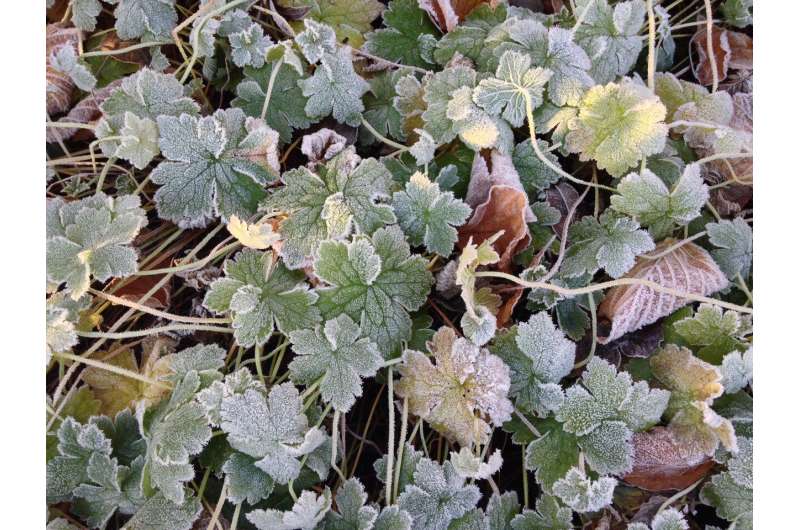This article has been reviewed according to Science X's editorial process and policies. Editors have highlighted the following attributes while ensuring the content's credibility:
fact-checked
peer-reviewed publication
trusted source
proofread
How plants cope with the cold light of day, and why it matters for future crops

On bright chilly mornings you can either snuggle down under the duvet or leap up and seize the day.
However, for photosynthesizing plants, this kind of dawn spells danger, so they have evolved their own way of making cold mornings tolerable.
Research led by the John Innes Centre has discovered a cold "coping" mechanism that is under the control of the plant biological clock and could offer solutions to breeding more resilience into crops less suited to cold climates.
"We've identified a new process that helps plants tolerate cold. It's controlled by the biological clock of plants, and we think it could be especially important on cold, bright mornings," says Professor Antony Dodd, a group leader at the John Innes Centre.
"Crops such as winter wheat and winter oilseed rape experience cold temperatures for periods of their cultivation," he continues. "We think that the mechanism that we have discovered could provide greater resilience of photosynthesis to cold temperatures. It represents an interesting target for future precision breeding of climate resilient crops."
Cold temperatures can damage plant cells, particularly when combined with too much light or during freezing temperatures. Hence why those bright cold mornings are so dangerous to plants.
The researchers wanted to know how information about low temperatures is communicated to the chloroplasts, the site of photosynthesis inside a plant cell, essential for all our major crops.
Chloroplasts contain their own small genome that reflects their evolutionary past as photosynthetic bacteria, before they were engulfed and co-opted by plants to carry out photosynthesis. Throughout evolution many genes from the chloroplast transferred to the plant nuclear genome, but chloroplasts have held on to some essential genes.
In this research the team focussed on one such bacterial genetic legacy called a sigma factor (SIG5). In bacteria, comparable sigma factors contribute to responses to temperature.
In experiments conducted under controlled laboratory conditions they manipulated the light conditions, and subjected plants to periods of chilling.
Removing plants from the day night cycle enables researchers to better study the free-running rhythms of the plant biological or circadian clock. In plants, as in humans, the clock is aligned to the 24-hour cycle, offering a measure of time inside cells, and regulating a range of essential biological processes.
The experiments showed sensitivity of the SIG5 gene to cold treatment early in the morning, under the control of the circadian clock.
The team theorize that SIG5 operates as part of a signaling network that links the plant nucleus to the chloroplasts, regulating activities that can protect the plant against harmful environmental effects.
"If the temperature is cold then some enzymes involved in photosynthesis break down quickly," explains Professor Dodd. "So, we think the process that is controlled by the nucleus signals into the chloroplast to make more of these proteins. When the plant sees cold and light at the same time, they need to switch on this signaling process from nucleus to chloroplasts to make more of these photosynthesis proteins."
The role of the biological clock is to act like a gate that either lets the signal through or not, a process known as circadian gating.
"Plants could have evolved to be particularly responsive to it being light and cold, like a spring morning, because these are the conditions that damage the photosynthetic system. At some point during evolution, they have selected for this sensitivity and co-opted this ancient mechanism. Like many such processes in plants, this one turns out to be under the control of the circadian clock."
The mechanism has been shown to work in the lab. The next stage of this research is to understand the impact of this process in the field. One intriguing application is to see if the mechanism can be modified to further increase cold tolerance, for example to grow plants that are less tolerant of cold, such as maize, at more northern latitudes.
The research is a collaboration between the John Innes Centre, the University of Bristol, Tokyo Institute of Technology and Nippon Telegraph and Telephone Corporation in Japan, and Durham University.
Low-temperature and circadian signals are integrated by the sigma factor SIG5, appears in Nature Plants.
More information: Antony Dodd, Low-temperature and circadian signals are integrated by the sigma factor SIG5, Nature Plants (2023). DOI: 10.1038/s41477-023-01377-1. www.nature.com/articles/s41477-023-01377-1
Journal information: Nature Plants
Provided by John Innes Centre




















